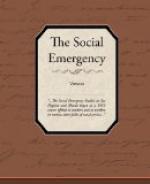* * * * *
The boy is normally clean and wholesome. His first question regarding the origin of life is a good question. When denied wholesome information, the further investigation which often follows is indicative of desirable qualities of character. Later, though disturbed by false ideas which have been forced upon him, he still wishes to be clean and strong. He desires to master low passions. He would rather have muscular strength and endurance and energy and will power and courage and chivalry than any amount of money. He shudders at the thought of causing suffering to an innocent woman or child. He would sacrifice his life for the girl whom he regards as the personification of loveliness and purity. If we will but deal with him fairly and honestly, he will see in birth an ever-recurring miracle; he will regard his body as a sacred temple; he will see in sex power a source of richer and fuller life; he will respect women; he will regard marriage as the most sacred relationship in life. Thus noble manhood, a nation’s greatest asset, will in large measure be achieved.
FOOTNOTES:
[41] John L. Alexander (editor), Boy Training. Association Press, New York, especially pp. 11 to 22.
[42] Pedagogical Seminary, vol. IX, no. 3. Worcester, Massachusetts.
[43] G. Stanley Hall, Adolescence, vol. I, p. 459.
[44] Prince A. Morrow in the Transactions (vol. I, p. 88) of the American Society of Sanitary and Moral Prophylaxis.
[45] Charles Wagner, The Simple Life, p. 181. (McClure, Phillips & Co.) Caleb Williams Saleeby, Parenthood and Race Culture. (Moffat, Yard & Co.) Francis G. Peabody, Jesus Christ and the Social Question, p. 162. (Grosset & Dunlap.)
[46] “What my Boy Knows,” American Magazine, New York, April, 1913.
[47] Robert E. Speer, Young Men Who Overcame, p. 21. (Fleming H. Revell Co., Chicago.)
[48] Charles Wagner, Youth, pp. 248-50.
[49] Charles Wagner, Youth, p. 246.
[50] The Boy Problem, Educational Pamphlet no. 4, p. 26, of the American Society of Sanitary and Moral Prophylaxis, 105 West 40th Street, New York.
[51] Jane Addams, The Spirit of Youth and the City Streets, p. 20. The Macmillan Company, New York.
[52] Emerson, Education, p. 38. Riverside Monograph Series.
[53] Henry Bryan Binns, Abraham Lincoln, p. 356.
[54] Charles Kingsley, The Roman and the Teuton, p. 46.
[55] Winfield S. Hall, M.D., From Youth into Manhood, p. 32. Association Press, New York.
[56] Hall, Reproduction and Sexual Hygiene.
[57] From an investigation conducted by Dr. Winfield S. Hall.
[58] “A Social Emergency,” First Annual Report of the Social Hygiene Society of Portland, Oregon, and the Bulletin of the Oregon Social Hygiene Society, vol. I, no. I.




